Intel Thunderbolt 4 Update: Controllers and Tiger Lake in 2020
by Dr. Ian Cutress on July 8, 2020 9:00 AM EST- Posted in
- CPUs
- Tiger Lake
- USB4
- Thunderbolt 4
- TB4

Wired connectivity is converging onto two standards: USB4 and Thunderbolt 4. Both of these are set to debut by the end of the year in Intel’s upcoming Tiger Lake platform, and to set the scene Intel is updating us on the scope of its Thunderbolt 4 efforts.
Thunderbolt 4 is going to be a superset of TB3 and USB4, meaning that any Thunderbolt 4 Type-C host will be able to accept TB4, TB3, USB4, and USB 3/2/1 connections. Thunderbolt 4 will offer speeds up to 40 Gb/s, and there are a number of requirements for Thunderbolt 4 hosts and devices in order to be certified.
These requirements include:
- Video, support 2x 4K or 1x 8K (No detail at what refresh/bit-rate/chroma)
- Data, PCIe at 32 Gbps (storage up to 3 GB/s)
- Support for TB4 docks with four TB4 ports (one upstream, 3 downstream)
- PC Charging on at least one port (for laptops up to 100 W)
- Wake from sleep by peripherals connected to a TB4 dock
- Requires Direct Memory Access protection (more on this later)
The first devices to come to market with TB4 support will be Intel’s Tiger Lake platform, for use in laptops, which will have TB4 baked right into the silicon. TB4 will be one of the base requirements for Intel’s Project Athena certification program, and Intel is set to release a new TB4 2m cable for most use cases. Intel is also working on optical 5-50 meter cables, which will also now support the TB4 multi-port accessory architecture, enabled by 4-port TB4 hubs.
There will be two host controllers, known as Maple Ridge JHL8540 and JHL8340, for use as host controllers in desktops, workstations, and laptops. We are told the package size and power requirements are essentially in-line with previous Titan Ridge TB3 controllers. The device controller, for use in docks, monitors, storage devices and such, is the Goshen Ridge JHL8440. All three of these controllers will be available by the end of the year.
Thunderbolt 4 has no costs associated with using it, the branding, or the logo, however there is a branding/logo license. Intel has opened up the TB4 standard, but as it stands is the only company that has publically announced its intention to make host and device controllers. The cables will be branded with the Thunderbolt Logo and a number 4, however ports on systems will only have the Thunderbolt Logo, making TB3 and TB4 use indistinguishable (we disagree with Intel that users don’t check what their system uses so using the same logo makes no difference to these users – we think the same argument can be used in order to showcase the logo on devices with the number 4).
Here’s a main slide showcasing the difference between all the different standards. Ultimately TB4 is backwards compatible with TB3 and USB4/3/2/1 standards.
One of the key focal points in our briefings with Intel is that Thunderbolt 4 will have an additional requirement this time round – Direct Memory Access protection to prevent physical attacks. In our briefing (and shown on the slide below), Intel initially stated that this requires Intel VT-d technology, which raised questions about Thunderbolt 4 being limited to Intel only systems.
The spokesperson later clarified that in order to gain certification, DMA protection is required, and Intel is using VT-d to do it. Intel refused to comment on how other vendors might implement DMA protection, stating that it would be up to them. While additional security protections are always a good thing, they ideally need to be based around open vettable standards, something which might limit Thunderbolt for another generation as an Intel-only technology (whereas USB is far more ubiquitous).
We’ve reached out to AMD late in the day, and they’ll be supplying a comment soon. I will update this post when I get something.
Update, AMD says the following:
The “Zen 2” architecture supports DMA security in pre-boot and OS environments via AMD-Vi (IOMMU) on USB and PCIe interfaces.
When asked specifically if AMD-Vi meets the requirements for TB4, AMD stated:
If the question is to do we support DMA? The answer is yes. Any questions about if this would satisfy another companies requirements for an interface they are developing would need to be directed at them.
When we asked Intel to confirm if AMD-Vi met the requirements for TB4's DMA protection, we were given the following quote:
Thunderbolt is open to non-Intel-based systems. Like any other system, devices must pass Thunderbolt certification and end-to-end testing conducted by third-party labs. Thunderbolt 4 requirements include Intel VT-d based or an equivalent DMA protection technology that provides IO virtualization (often referred to as IO Memory Management Unit or IOMMU), as well as OS implementation support. If the equivalent technology supports prevention against physical attacks, then that should meet the requirement.
Overall, TB4 seems like a very capable standard, providing backwards compatibility, top class speeds, as well as new connectivity topologies. It will be interesting to see what the additional cost of adding TB4 onto various systems will be with Intel’s controllers, especially in the desktop space.



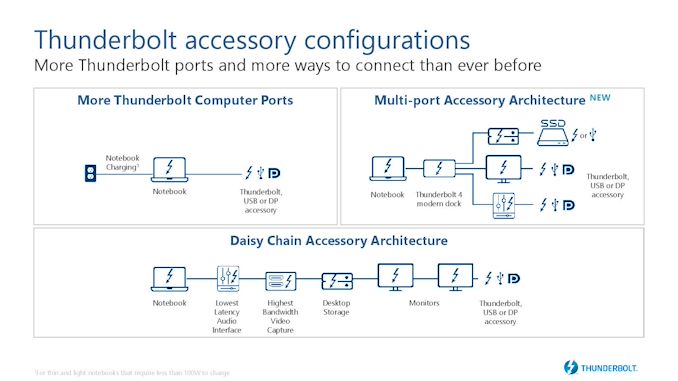
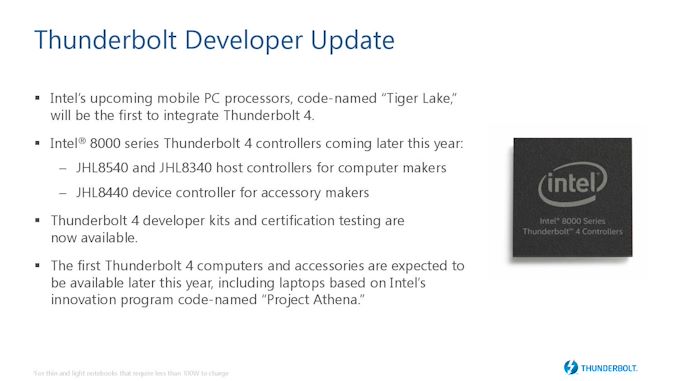

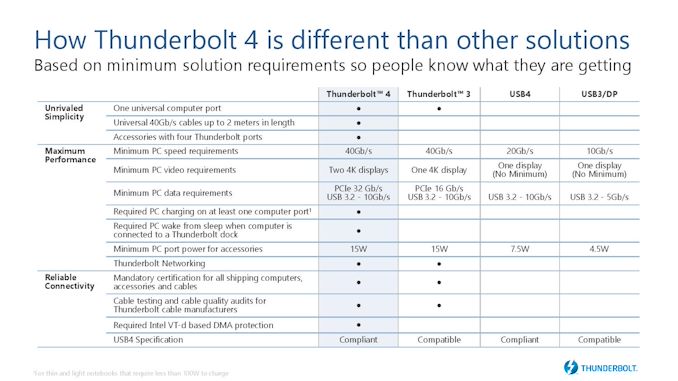
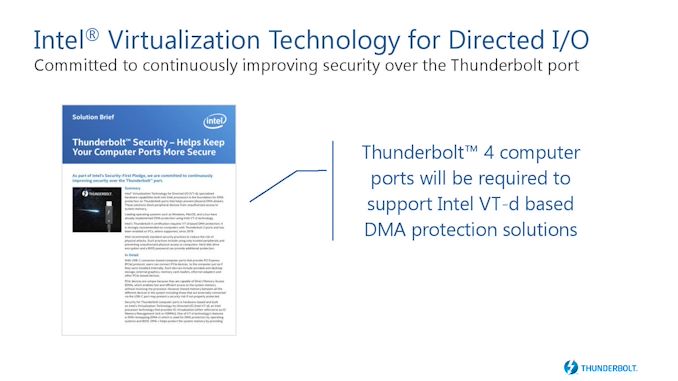
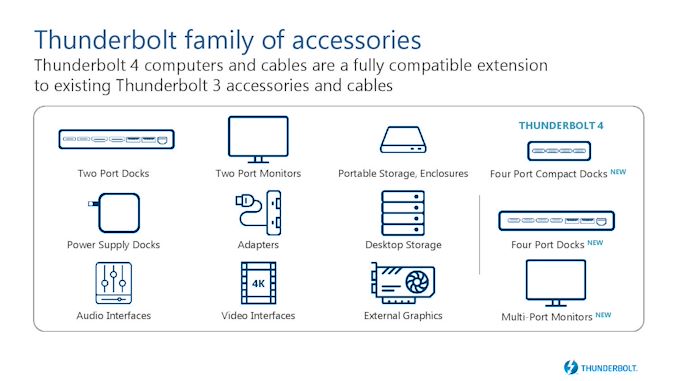














76 Comments
View All Comments
KPOM - Wednesday, July 8, 2020 - link
Will we be able to use a 2 meter Thunderbolt 4 cable with existing TB3 ports, and get the benefits of full USB 3.2 speeds? Right now, the only 2-meter TB3 cable I know of that also supports 10gbps USB 3.2 is Apple’s $129 cable.Valantar - Wednesday, July 8, 2020 - link
I was wondering the same thing - longer cables is one of the most basic needs for TB3. Of course if I/O speeds are to keep rising we'll need to move tho active cabling as a default sooner rather than later (with all the added cost that brings), but for now I would love 2m TB4 cables to also work as TB3 and USB 3.2 cables (given that ny 10Gbps USB-C cable should work as a TB3 cable this ought to be possible). Though i suspect what they are doing is making a low-cost active cable with limited length, which would limit its backwards compatibility.Limiting the 4-way hubs to what seems to be a minor update to a protocol also seems like an odd lock-in for no real reason. Couldn't support for this be patched into existing controllers?
repoman27 - Wednesday, July 8, 2020 - link
The $129 Apple cable is active, hence the price tag. The problem with active cables that support multiple protocols is that you need redrivers / retimers that can handle all of the necessary signaling rates. For Thunderbolt 4 that would include:USB4 Gen 3 / Thunderbolt 4 / DisplayPort UHBR 20 - 20 Gbit/s
USB4 Gen 2 / USB3 Gen 2 / DisplayPort UHBR 10 - 10 Gbit/s
USB3 Gen 1 - 5 Gbit/s
Thunderbolt 3 - 20.625 Gbit/s
Thunderbolt / Thunderbolt 2 - 10.3125 Gbit/s
DisplayPort UHBR 13.5 - 13.5 Gbit/s
DisplayPort HBR3 - 8.1 Gbit/s
DisplayPort HBR2 - 5.4 Gbit/s
DisplayPort HBR - 2.7 Gbit/s
DisplayPort RBR - 1.62 Gbit/s
In either direction on each of the four high-speed differential signaling pairs. Even if someone starts cranking out suitable low-power chips that can handle this task, a 2.0 m cable is still probably going to cost somewhere in the neighborhood of $80.
repoman27 - Wednesday, July 8, 2020 - link
Oh, and re: the hubs, Intel has never offered a discrete Thunderbolt controller with more than two ports. Being limited to one port for upstream and one port for downstream made daisy chaining the only possible topology. Now with Goshen Ridge, vendors can finally build hubs with a single upstream facing Thunderbolt port and up to 3 downstream facing Thunderbolt ports.And no, existing controllers can't be patched to add additional ports or USB4 support. However, Thunderbolt 4 docks / hubs will be compatible with Thunderbolt 3 hosts / devices.
Valantar - Wednesday, July 8, 2020 - link
According to the spec table/compatibility list in the article the 4-port hubs ("accessories with four thunderbolt ports") are only compatible with Thunderbolt 4, and there is no mention anywhere about these being backwards compatible. Which, as I said, seems like an unnecessary lock-out which I am surprised if couldn't be patched in via firmware of they wanted to. I never said anything even remotely close to patching in support for more lanes from the controller, nor patching in TB4 support.To your previous comment, as I said, I expect Intel's new 2m cable to be a cost-down active cable, but a passive cable would be really great exactly because backwards compatibility ought to be simple.
All in all, not to sound crass, but maybe work on your reading comprehension a bit? Both of your comments address things my comment already addressed...
repoman27 - Wednesday, July 8, 2020 - link
No offense taken, and if you think my reading comprehension is off, you should check out my listening comprehension!Sorry, my first comment there was more directed at KPOM. And my responses reflected my reading of the specs and Intel's slide decks rather than what Ian wrote. At 20 Gbit/s, passive cables are limited to 0.8 m, and a 2.0 m cable will necessarily be active. I'm pretty sure Ian has mistaken Intel marketing's use of the royal "we" when it comes to the cables. That's really not Intel's bag. And my point was that if Apple is currently selling nearly the same cable for $129, even Monoprice will have trouble cracking $80. And if Intel were to start making the redriver / retimer chips for these types of cables, I wouldn't expect prices to go down at all. So to sum up, Intel doesn't have a 2m Thunderbolt 4 cable, but if they did, it would be both active and expensive.
Also, by way of the USB4 spec, all of the downstream facing ports on Thunderbolt 4 docks and hubs as well as the upstream facing port on Thunderbolt 4 docks are required to support interoperability with Thunderbolt 3 products. Therefore the Goshen Ridge silicon necessarily supports Thunderbolt 3 on all 4 ports. Which also means it is fully backwards compatible with Thunderbolt 1 and 2 using an adapter.
You said, "Limiting the 4-way hubs to what seems to be a minor update to a protocol also seems like an odd lock-in for no real reason. Couldn't support for this be patched into existing controllers?"
I read that as, "Limiting the 4-way hubs to [Thunderbolt 4] seems like an odd lock-in for no real reason. Couldn't support for this be patched into existing [Thunderbolt 3] controllers?"
Therefore my response was that the 4-port silicon really does support all the Thunderbolts, but obviously you can't add USB4 or more ports to the existing Thunderbolt 3 chips via a firmware update.
Jon Tseng - Wednesday, July 8, 2020 - link
Dumbass question - will TB4 make an eGPU soln faster?Asking for a friend who might want to fire up Cyberpunk 2077 on his hypothetical Tiger Lake laptop..
Techtree101 - Wednesday, July 8, 2020 - link
Soln? Potentially, yes, because more power can be fed to a eGPU solution.Jon Tseng - Wednesday, July 8, 2020 - link
Hmm. Was thinking more in terms of some external GPU being bottlenecked in terms of PCI lanes (or other bandwidth factors) when being used externally. I guess an RTX is gonna have an external PSU anyhow. Dunno if TB4 helps the situation re: bandwidth?Eliadbu - Wednesday, July 8, 2020 - link
eGPU solutions usually have their own power supply and they also deliver power to the computer. So I don't see this enabling them to be faster. The issue is the limited data rate of the PCI-E 3.0 4x in addition to other overheads that come due encapsulating the PCI-E when transmitting the through thunderbolt connection.